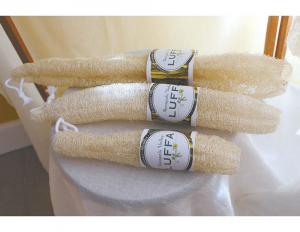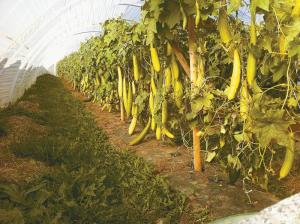2019 - Volume #43, Issue #4, Page #08
[ Sample Stories From This Issue | List of All Stories In This Issue | Print this story
| Read this issue]
She Grows Organic Luffa
 |
 |
“I was looking for a profitable crop to grow in my retirement years,” Oulton explains. Luffa caught her attention when she was working as a surveyor in the oil fields and read about it being used to absorb oil spills.
After she returned to Nova Scotia in 2014 and did a couple years of internet research, in 2016, she leased 100 ft. of space in one of her nephew’s high tunnels (www.taprootfarms.ca). Because luffa takes 200 days to mature, she started seeds in a greenhouse in March, then planted the seedlings in the tunnel around mid-May. The experiment worked and she had her first harvest by October, though she had to make some modifications in the process.
“In southern climates the luffa turn brown and get light on the vine as the fiber is developing and they dry,” Oulton says. Her luffa usually stay green and require additional drying steps.
She peels off the thin outer skin and washes the luffa in warm water. Then she “flings the heck out of it” to remove seeds and excess water and lets it dry thoroughly on a drying rack. Oulton sells luffas whole for $25 to $38, ranging from 10 to 22 in. long, as well as adding cords for bath luffas ($12) and slicing them into clothlike pieces for scrubbers ($8).
“Luffas are also referred to as the dish cloth gourd. They are great for the kitchen. I use them on stainless steel and cast iron and they last for 7 months,” Oulton says, adding they never smell as long as they are rinsed and allowed to dry between uses.
Since her first crop, she has expanded to 1,200-ft. of trellising in two 200-ft. tunnels. This year she added a new Egyptian luffa variety that has a softer texture.
Growing luffa is labor-intensive, Oulton says, because the vines need to be trained to grow up on a trellis and pruned as the luffas grow. Being organic adds extra challenges. She adds calcium and nitrogen based on soil testing. Pests such as the cucumber beetle and squash bug are the biggest problem, because it is difficult to find non-chemical solutions. The squash bug destroyed a large portion of last year’s harvest so this year she put tin foil on the floor and hung shiny streamers because the bugs don’t like reflective surfaces.
Though being organic makes it more challenging to grow luffa, being natural is important to Oulton. She sells her luffas at about 30 Canadian stores and at farmers markets. She appreciates mentoring from FarmWorks Investment Co-operative Limited and recent media publicity that has helped educate consumers about luffa. “Customers tell me they love how luffa feels on their skin,” she says.
By the end of 2019, she expects to have a website to sell her products in Canada and the U.S. Also this season she may try to harvest young luffa, which is called Chinese okra and edible in soups and sauces.
“My pie-in-the-sky goal is to have five tunnels and sell luffa coast-to-coast in five years,” Oulton says. “I hope to inspire other luffa growers to offer this basic product to consumers.”
Contact: FARM SHOW Followup, Cindy Oulton, Annapolis Valley Luffa, 506 Avonport Rd., Avonport, N.S. B0P 1B0 Canada (ph 403 370-8766; www.luffacanada.ca; cindy@luffacanada.ca).

Click here to download page story appeared in.

Click here to read entire issue
To read the rest of this story, download this issue below or click here to register with your account number.




